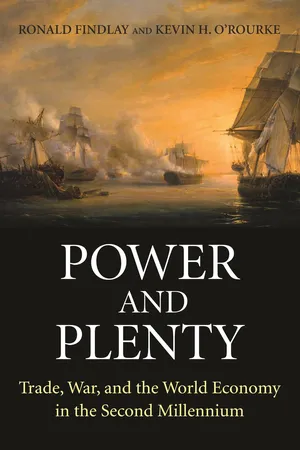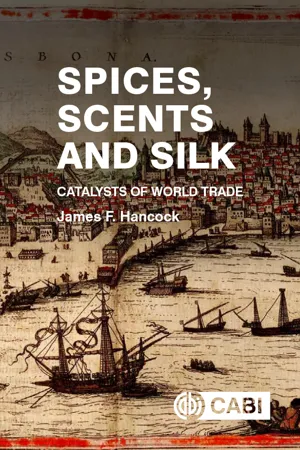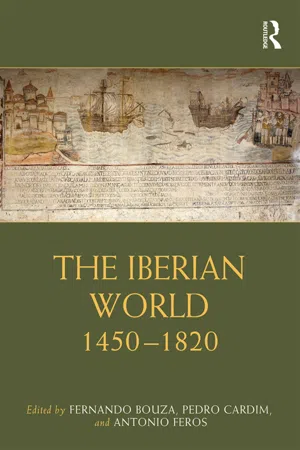History
Treaty of Tordesillas
The Treaty of Tordesillas was signed in 1494 between Spain and Portugal to divide the newly discovered lands outside Europe. The treaty established a line of demarcation, giving Spain the right to explore and colonize the lands west of the line, while Portugal had the same rights to the lands east of the line. This treaty helped to avoid conflicts between the two countries over their territorial claims.
Written by Perlego with AI-assistance
Related key terms
Related key terms
1 of 4
Related key terms
1 of 3
3 Key excerpts on "Treaty of Tordesillas"
- eBook - ePub
The Princeton Economic History of the Western World
Trade, War, and the World Economy in the Second Millennium
- Ronald Findlay, Kevin H. O'Rourke(Authors)
- 2009(Publication Date)
- Princeton University Press(Publisher)
Exploitation of the Spice Islands did not prove easy since the Portuguese were already installed on the rival island of Ternate. Hostilities broke out between the Christian rivals, each aided by a local Muslim ally in the person of the respective sultans of Ternate and Tidore. The disputes were not confined to the military, commercial, and political levels but extended to cosmography as well, since by the Treaty of Tordesillas of 1494 the pope had divided the newly discovered lands of the world between the two Iberian powers based on a meridian 270 leagues west of the Cape Verde Islands, with Spain getting everything to the west and Portugal everything to the east. The question was, which side of this Tordesillas Line, extended around the globe, did the Spice Islands lie on? Realizing that whatever his legal claims might be the Portuguese had the advantage of the proximity of Melaka, Charles V wisely settled for the sum of 350,000 ducats by the Treaty of Saragossa in 1529, to the disgust of many of his subjects.O. H. K. Spate (1979) entitled the first volume of his great history of the Pacific The Spanish Lake and so it was, despite many challenges, for almost two centuries after Magellan. It is not clear, however, what immediate economic advantage the Spanish Empire derived from all the heroic voyages her mariners made in the vast expanse of these waters in search of treasure, spices, and souls for conversion to the true faith. The only lucrative opportunity, but one that was to persist for centuries, was the exchange of American silver for Chinese silks, with many other items of lesser value thrown in, taking place through Manila in the Philippines, the only Spanish colony in the Pacific. The islands were claimed and named in honor of the future Philip II in 1542, but effective occupation and settlement only began with the expedition of Miguel López de Legazpi that was sent out from Mexico in 1564.Legazpi seized the site of Manila with its splendid natural harbor from a native Muslim ruler in 1571, and extended control over most of the main islands before his death in 1572. A significant exception was Mindanao with a formidable Muslim presence that has persisted to this day. Conversion to Christianity, under the enlightened leadership of the Augustinian friar and explorer Andrés de Urdaneta, proceeded rapidly. Many Chinese were already attracted to the islands before the Spanish arrival, but the appearance of the galleons from Acapulco at Manila from 1571 onwards was a transformational event in the history of world trade, inducing a large inflow of Chinese immigrants from the mainland despite the necessity of purchasing permits from the Spanish authorities to do so legally. The walled city contained the Spanish administrators, soldiers, and clergy together with their Filipino Christian converts, surrounded by a much larger extramural Chinese community of artisans and traders, only a few of whom converted. With the Ming dynasty in full control of the Chinese mainland, and frequent incursions by formidable Chinese pirates and warlords, it is not surprising that the immigrant Chinese population, indispensable as it was to the economic viability of Manila, came to be feared as a sort of potential “fifth column” by the Spanish administration. - eBook - ePub
Spices, Scents and Silk
Catalysts of World Trade
- James Hancock(Author)
- 2021(Publication Date)
- CAB International(Publisher)
Romanus Pontifex, granting the Spanish not only the lands across the Atlantic, but also ‘all islands and mainlands whatsoever, found and to be found, discovered and to be discovered, that are or may be or may seem to be in the route of navigation or travel towards the west or south, whether they be in western parts, or in the regions of the south and east and of India’ (Anonymous, n.d.).This bull infuriated João II, as it gave Spain claim to all that the Portuguese had already discovered along the western coast of Africa and the territories in the Indian Ocean that they were forging a pathway towards. He went directly to Ferdinand and Isabella who were happy to compromise with him, being quite satisfied with their new western discoveries and respectful of Portugal’s growing power. In a small town in central Spain, Tordesillas, a treaty was soon negotiated and signed in June 1494 that divided the world into halves along a line drawn 70 leagues (~240 miles) west of that placed by Pope Nicholas V. All to the west of this line was to be Spain’s and all to the east was Portugal’s. The power of these two nations was so great that ‘they could partition the entire planet like two schoolchildren swapping marbles at recess’ (Bernstein, 2008 , p. 168).Vasco da Gama Discovers an Unknown WorldWith ownership of the world now split into halves by treaty, it was high time for Portugal to finish its quest for the sea route to India. The nobleman Vasco da Gama was chosen by João II to complete this task. João II’s goals for him were straightforward, albeit challenging: find the route to India, wage holy war on the Moors and locate Prestor John. Da Gama was given a squadron of four well-armed ships, three years of supplies and a store of cheap goods to trade with what was assumed would be unsophisticated natives. The trinkets they carried ‘to delight a West African chief were: brass bells and basins, coral, hats and modest garments’ (Crowley, 2015 - eBook - ePub
The Iberian World
1450–1820
- Fernando Bouza, Pedro Cardim, Antonio Feros, Fernando Bouza, Pedro Cardim, Antonio Feros(Authors)
- 2019(Publication Date)
- Routledge(Publisher)
The war ended with the signing in September 1737, in the Low Countries, of a new treaty, intermediated by France and England, but which, once again, did not definitively put an end to the differences between the two nations. On the contrary, alongside Portugal, there grew the perception that neither Tordesillas nor the other agreements already signed accounted for the actual colonisation or their true territorial interests in South America. In this way, in the eighteenth century, which witnessed a “succession of congresses” (Bély 1990, 12), the pending questions between the two Iberian nations related to South America were again raised in the treaties of Breda (1747) and Aix-la-Chapelle (1748), which resulted in the agreements of Madrid (1750), El Pardo (1761), and San Ildefonso (1777).The Treaties of Madrid and El Pardo and the impacts of the Seven Years War
What became the Treaty of Madrid could be glimpsed from 1746 when, following the death of Philip V (on 9 July)—who had been pro-French and openly averse to reaching an understanding with Portugal—Ferdinand VI ascended the Spanish throne, having been married since 1728 to Maria Bárbara de Bragança, daughter of João V. In the episode known as the exchange of princesses, the future king of Portugal, Dom José, in turn, married the Spanish princess, Mariana Vitória de Bourbon. In September 1746, the Portuguese ambassador, Tomas da Silva Teles, Viscount of Vila Nova de Cerveira, left for Spain to assume his position (AUC. CDLC. Doc.894, Carta de Tomás da Silva Teles para dom Luís de 3 de setembro de 1746, f. 1), and the negotiations with the Marquis de la Ensenada soon began. An epitome of an enlightened reformer, Ensenada had been one of Philip V’s advisors, and continued to enjoy great prestige in the reign of Ferdinand VI. He was, successively, Secretary of Finance, the Navy, War and the Indies, and Secretary of State. Supported by Maria da Bárbara, he was appointed her secretary in 1747. In the first conference between the Portuguese diplomat and the Spanish minister, on 12 November 1746, they discussed the “possibility of resolving the dependencies of Colónia do Sacramento and the commercial relations between the two countries”, beginning lengthy negotiations, which dragged on until 1750 (Cortesão 1953, 23–26).
Index pages curate the most relevant extracts from our library of academic textbooks. They’ve been created using an in-house natural language model (NLM), each adding context and meaning to key research topics.
Explore more topic indexes
Explore more topic indexes
1 of 6
Explore more topic indexes
1 of 4


